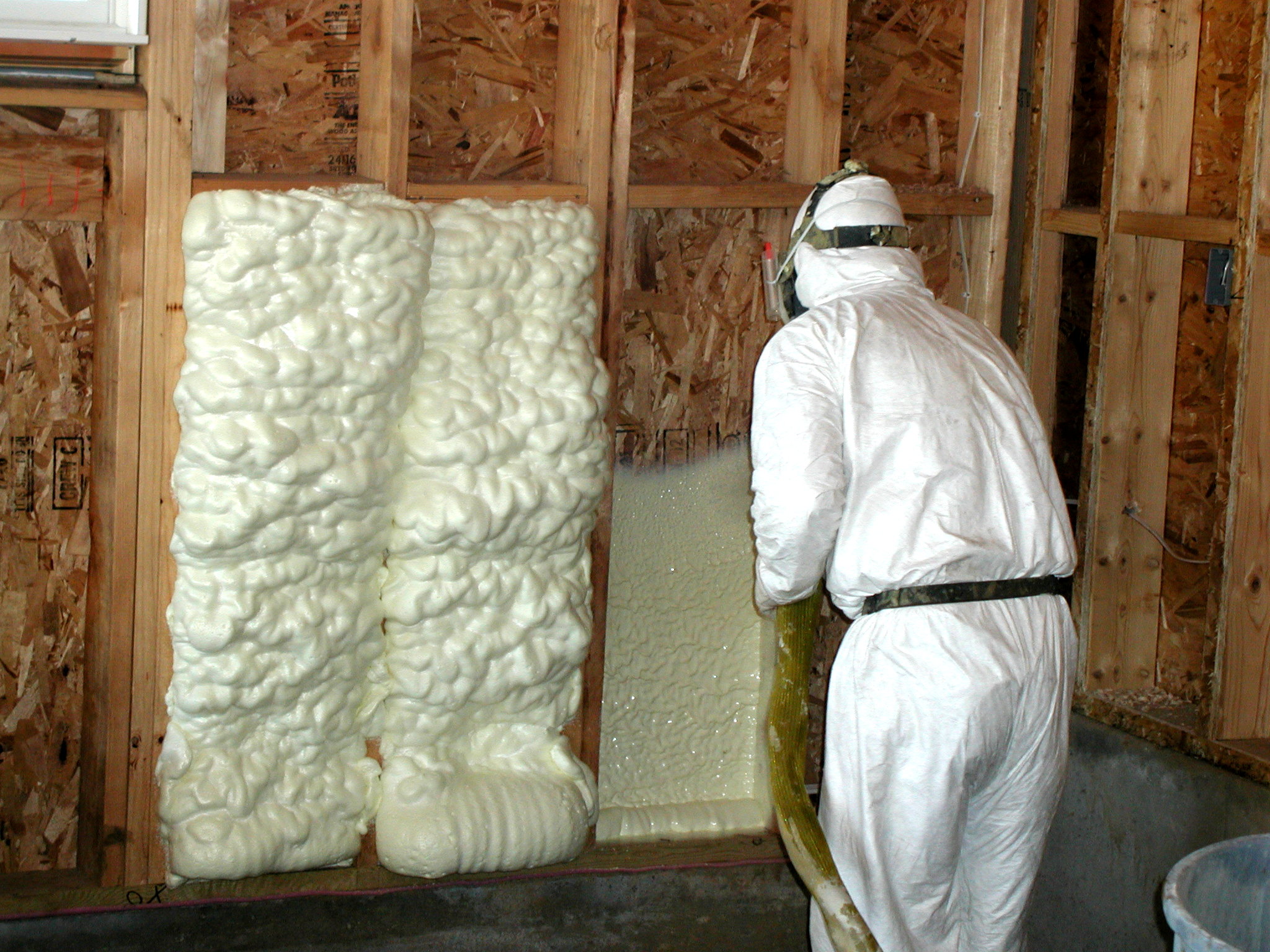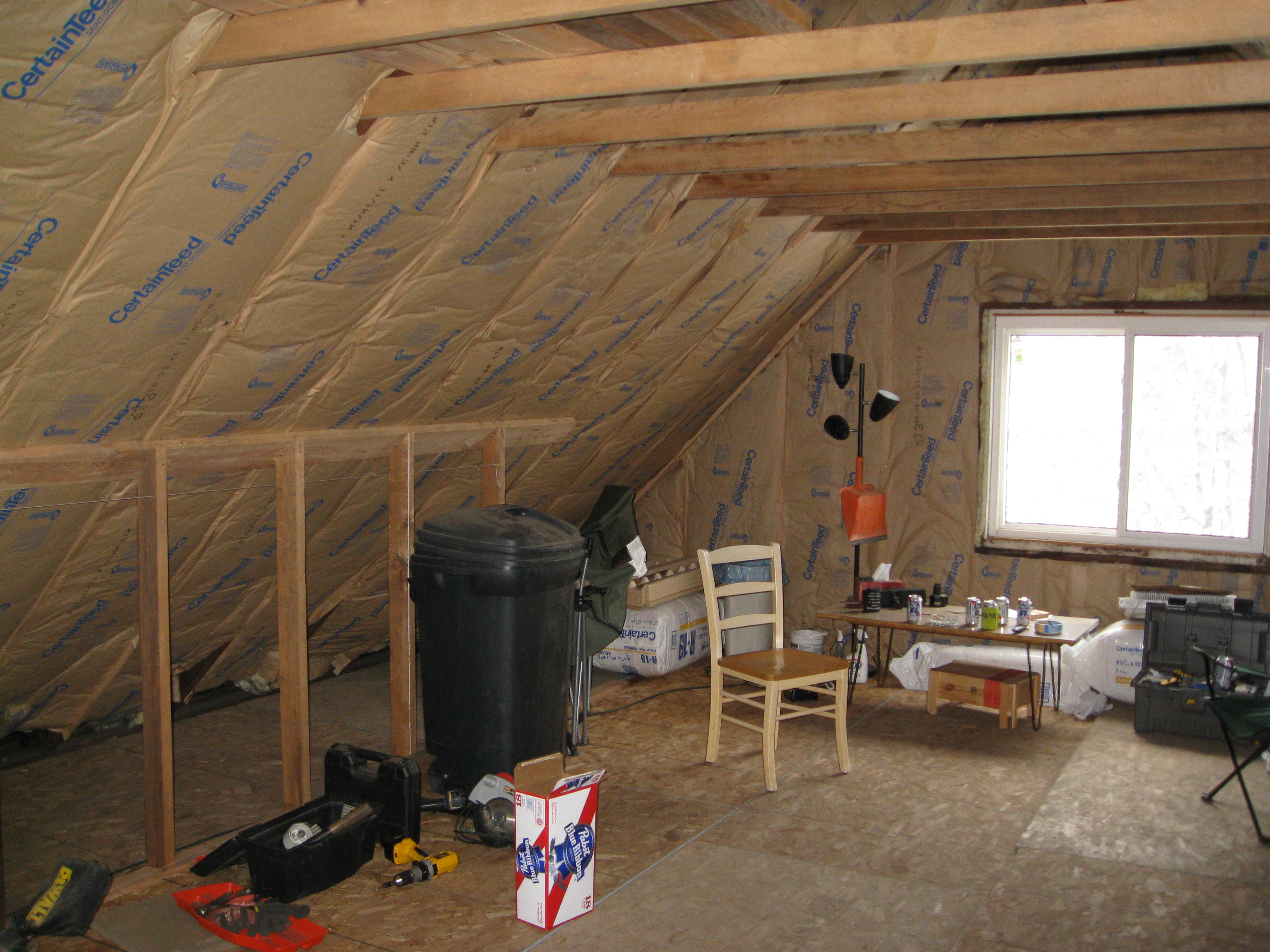Icicles and Ice Dams On My Own Home – Newsflash! I’m Not Perfect Either
I’m going to do something pretty dangerous with this post: open myself up to criticism. Why? Because I want to learn, and that requires openness. It shows I’m human as well. (Pros: please read carefully and see if you think I missed anything.) It’s also an example of the shoemakers’ kids going barefoot (or perhaps stocking-footed, my house is still in pretty good shape). I want to thank Ed Voytovich of Halco in New York with his blog post showing other houses and then his own for inspiring me to show my own. On with the show!
The night we got back from vacation, 12/20, the temperature dropped and it snowed off and on over 2 weeks while staying almost entirely below freezing, but not super cold. Perfect conditions for icicles.
This ‘storm’, my word for a period where it snows and stays below freezing, was rather unusual in that the houses in really bad shape seemed to drop their icicles before they got bad during the few hours the temp went above freezing while houses that typically didn’t get ice grew some real winners – like mine.
So I’m going to walk you through my diagnosis and future plans to fix the few issues with my house. Unfortunately the fixes will probably wait until summer when work slows down a bit (shoemakers’ kids syndrome).
Let’s start with a tour around my house. It’s very old for Ohio, built in 1835, and is literally built like a barn with post and beam construction. It is believed to be the original general store for Mantua and is on the National Historic Register.
To help orient you, here is a sketch of the floorplan:

Here is the front, which faces South:
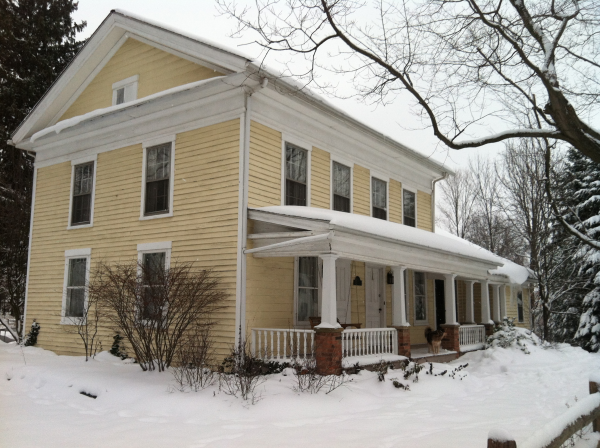
Note that the front porch has all of its snow on the roof and no ice in the gutters. This is because there is no heat to melt the snow there. The upper roof has very little ice because it is well insulated and air sealed.
If you look closely right before the last window, you can see an embarrassingly large icicle. Here is a better shot:
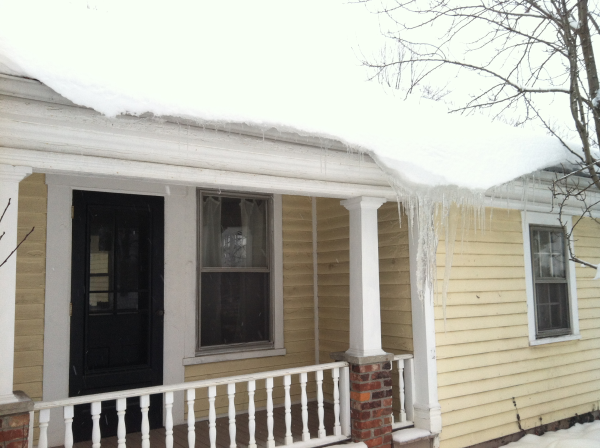
Yep, that’s embarrassing! It also tells me that there is a large heat source causing it. The heat source is most likely right by the wall at the side of the porch. Heat leaks are almost always right in line with the icicles below them. An uninsulated hatch will often leave a square hole of melted snow in the roof and an icicle right below.
One closer shot of the icicle:

So are you wondering what caused this monster? I’m not. Here’s the culprit, can you spot it?
I’ll give you a minute…
…
…
…
…
The cause of the icicle is actually a touch of hypocrisy on my wife and I’s part: we love old appliances; they just look better. This used to be the place for the stove, but our old fashioned one…

… didn’t fit in that space. Meanwhile, our tiny Admiral fridge fit right in. This swap caused a few problems. The biggest pain for us is that the thermostat is now right by the oven. Oops. It freezes out my wife’s office next to the kitchen because the thermostat thinks it’s warmer than it is. And being an old house, moving the thermostat isn’t as easy as it should be.
It also means that the old stove vent is now right above the fridge, which creates quite a bit of heat while cooling its contents:
So the fridge is 68.5 degrees, which is room temperature.
That 4 degree difference doesn’t seem like that big of a deal, but it’s enough to get the heat rising into the attic.
The stove vent is ducted through the attic about 2 feet over the insulation. When I insulated the attic, it slipped my mind, and we didn’t wrap it with any insulation. So all that heat coming off the fridge ends up in the attic. Doh!
I do really wish I hadn’t forgotten about that, but I did. It will get fixed this year.
Just so you don’t think I skimped on insulation in my attic, here is a picture of it:
16 inches of cellulose is R-60 once settled, which this is. That’s a gable vent in the background, and here’s a little of the post and beam construction:
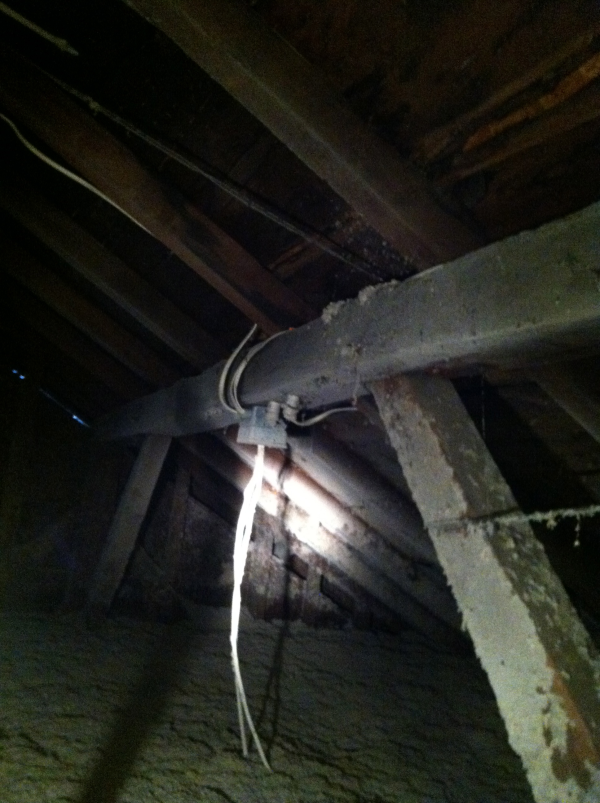
OK, let’s finish the tour around the outside of the house so you get the full picture. Here is the right side:
You can see the exhaust for the kitchen stove fan vent over the left window. (Pros: the knee wall to the second floor just out of view on this picture is insulated with R-13 batts and reflective insulation, thanks Sean Lintow Sr. for asking.) See the chimney on the right? That’s another heat source, more on it in a minute. Here is the rear of the house:
See the square in the center of the main house with the black stain above it? That’s my direct vent fireplace. It dumps a fair amount of heat right below the eave and often causes an icicle right there. We hadn’t been using it much when this was taken, so not much ice yet. Note that the 2 story section of the house has very little ice (I know it’s hard to see here, but it’s true.)
The one story section, though, has a few issues:
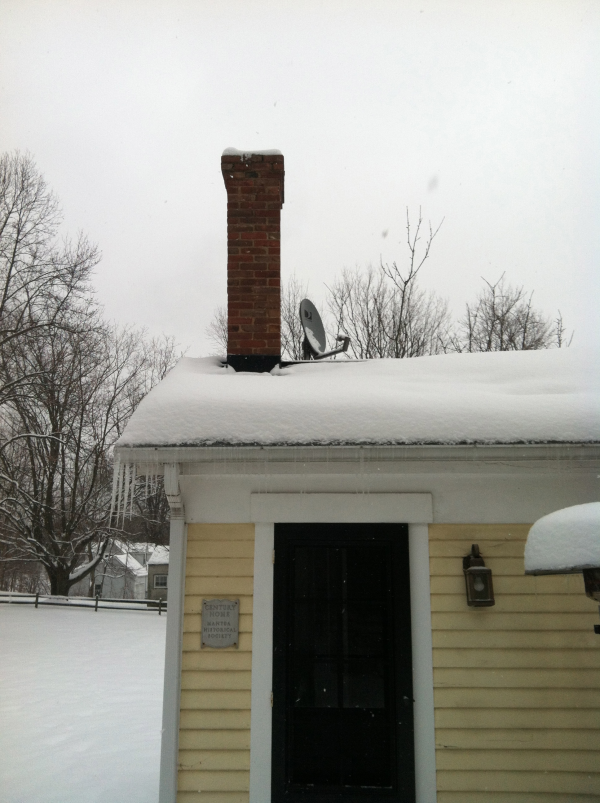
See those cute little icicles on the left? There’s not much I can do about them for the moment because the chimney is handling the heat from the boiler and water heater, and that heat is melting some snow. If you look closely, you can also see that the snow on the roof right below the chimney is melted, another sign of heat leakage. Things like this are a few examples of why it is impossible to guarantee complete elimination of icicles. There are a lot of heat sources I don’t have direct control over.
I will eventually fix this by putting in a high efficiency boiler that does not vent through the chimney, but there are a number of priorities before I get there (like the maple tree I can actually see through that needs to be cut down.)
The back porch is affected by the heat of the stove fan vent and the intake ventilation that I put on the roof back there is currently mostly blocked by snow (although snow does still allow a lot of air flow), so it gets a little ice too:
You can also see about 1″ of ice on top of the gutter here, that happens before the icicles spill over. Behind that ice in the gutter is a pool of water, and that is where the water comes from when it comes through your ceiling. See the diagram on my icicle and ice dam page. When the ice gets thick and heavy enough, it will pull down your gutter. There is nowhere near enough ice here to worry about losing a gutter.
OK, a few last points and I’m done. First a look at the back of the main house:
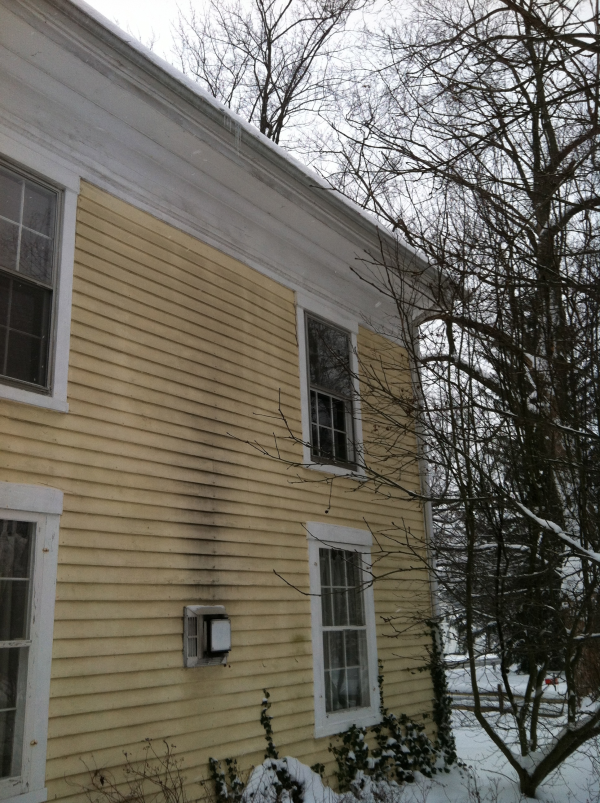
The dumb fireplace certainly leaves a big streak up the wall! I just cleaned it over the summer. And if you look right above it, there is a small icicle. The heat going up the side of the house and ending up below the eave is causing that icicle. I’ve seen dryer vents do the same thing when they come out below an eave. Speaking of eaves:
Note that I don’t have any ventilation in the soffits (also known as eaves) of my house. Typically they are rectangular vents or a 2″ strip all the way across. From a historical standpoint, I don’t like how they look, so I didn’t install any. Soffit vents allow the air into the attic, so they are intake ventilation. (Check out my ventilation page.) The first story attic does not have any intake ventilation in the soffits, either. This is causing a problem on the first story attic because there is not enough airflow to remove the heat from the kitchen stove vent fan, even though the attic is well insulated and air sealed aside from that.
The main attic has 2 massive gable vents and a ridge vent which provide enough ventilation to prevent icicles when paired with insulation and air sealing.
So that’s my house! It’s not perfect, but I know where the problems are, and at least I can fix the big icicle in the front. It also proves that I am indeed human, in case you hadn’t figured that out already…
If you live in Northeast Ohio, I’m happy to come diagnose your house, and I won’t miss that random vent line in the attic! Just call 330-524-6495!
P.S. I noticed the ice was worse on my house than usual during this storm, same with other houses that don’t normally have ice issues. I have a hypothesis for that in the next post coming later this week. (Holy cow, I’m writing more than a post a month in busy season, woohoo!)
Further Reading
Energy Smart Blog on the wall insulation in my house: Why I don’t like spray foam insulation for existing home walls.
Energy Smart Blog: Why do I get icicles and ice dams? How do I solve the problem?
Energy Smart Page on Icicles and Ice Dams even more in depth page on my website.
Energy Smart Blog: Why well insulated homes get icicles and ice dams.
Get the HVAC Guide

It's free! Make buying a new furnace, air conditioner, or heat pump less stressful.



